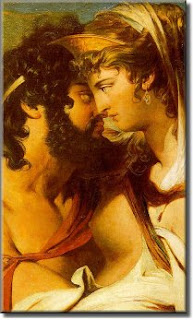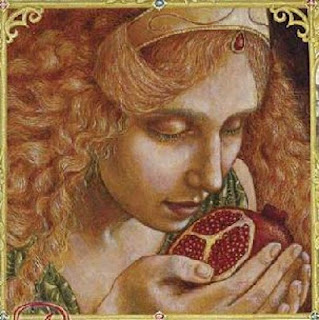Greek religion shifted from worshiping of local deities in form of satyrs, shades, furies, nymphs, sibyls and muses to the worship of Olympian pantheon headed by Zeus and his wife Hera. This religion originally consisted of simple rituals and involved into complex system of science and philosophy.
 |
| Zeus and Hera |
Magic was a common topic in literature like Homer´s Iliad and Odyssey. The Odyssey in particular was recognized as a book of magic and its verses were used as magical formulas.
The Greeks were polytheists ( they believed in many gods ).
Unpopulated areas were dedicated to the gods. Oracular temples were built near volcanic chasms or caverns. Thanks to oracles humans can get closer with gods. The best known is Delphic oracle on Mount Parnassus where people traveled to learn about future from Pythia or priestess of Apollo who would pronounce their fate in an intoxicated frenzy.
The most prominent witches in Graeco - Roman myths and literature were Circe, witch visited by Odysseus. Medea, the niece of Circe, who helped Jason with the Golden Fleece quest and Hecate, goddess of the underworld.
 |
| Circe offering the cup to Ulysses |
The Greeks practised a form of rites called Mysteries, which were known only to those who had been initiated. The most famous were the Eleusinian Mysteries. After a preparatory purifying stage that led the neophyte to a state of readiness, sacred objects were shown and it is thought likely that the myth of Demeter and Persephone was performed as a form of initiation into the process of life and death. Demeter as a mother of life and death and with her daughter Persephone represents the upper and lower worlds.
Persephone was abducted by Hades, the ruler of the underground, because she has eaten the food of dead. She must spend one third of the year underground with Hades and two thirds above the ground with her mother Demeter. Upper and lower worlds are separated and reunited in a continuous regeneration as Demeter repeatedly loses and finds Persephone.
The practice of magic brings power but it has also its pitfalls as is describe in The Golden Ass by Lucius Apuleius in the second century AD.
 |
| Persephone has eaten fruit of the dead in form of pomegranate seeds |
In a story, young naive Apuleius is transformed in to an ass while trying to imitate a witch who is able to change herself into an owl. As an ass he undergoes many trials and is mistreated by many masters. He escapes to the beach and prays in the moonlight to goddess Ceres. She tells Apuleius that the next day there will be a festival in her honor and if he eats a garland of roses carried by a high priest he will be transformed back in human form
Roman religion adopted the Greak pantheon with Romanized names. In addition several cults taken from other traditions arose during the period: of particular note were those of Isis, Mithras ( the Persian god of meditation between light and dark), and Christianity, which eventually became the state religion of the Roman Empire.
0 comments:
Post a Comment